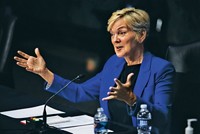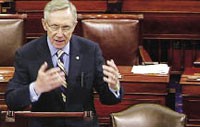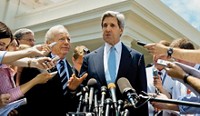Advertisement
Grab your lab coat. Let's get started
Welcome!
Welcome!
Create an account below to get 6 C&EN articles per month, receive newsletters and more - all free.
It seems this is your first time logging in online. Please enter the following information to continue.
As an ACS member you automatically get access to this site. All we need is few more details to create your reading experience.
Not you? Sign in with a different account.
Not you? Sign in with a different account.
ERROR 1
ERROR 1
ERROR 2
ERROR 2
ERROR 2
ERROR 2
ERROR 2
Password and Confirm password must match.
If you have an ACS member number, please enter it here so we can link this account to your membership. (optional)
ERROR 2
ACS values your privacy. By submitting your information, you are gaining access to C&EN and subscribing to our weekly newsletter. We use the information you provide to make your reading experience better, and we will never sell your data to third party members.
Environment
Climate Conflicts
Congress faces great pressure, sparse unity as it gears up for next year's climate-change battle
by Jeff Johnson
July 14, 2008
| A version of this story appeared in
Volume 86, Issue 28
LAST MONTH'S FAILURE by supporters of climate-change legislation to muster enough votes to formally bring a bill to the Senate floor signals what lies in store for Congress next year when it rejoins this thorny debate. The success of opponents in blocking legislation may show their reluctance to actually vote on the bill's provisions, but congressional members appear more than willing to argue over the impact and costs of reducing carbon dioxide emissions.
Over two weeks in late June, four congressional hearings focused on climate change. House and Senate members argued about national security impacts, legislative approaches to cut carbon dioxide, the cost of action and inaction, and ways to meet future energy demands in a carbon-constrained world. Sprinkled throughout the sessions were speeches and testimony from more than a dozen experts from all parts of the spectrum.
Everyone in the world is affected by climate change, and on the basis of these hearings, it appears everyone in the U.S. will be affected one way or another by attempts to mitigate it.
Members of Congress are under a lot of pressure. Constituents worried about the impact of climate change on their lives and energy bills are calling on their representatives to act. Congressional members are also facing a growing wave of lobbyists who offer their views along with campaign support and dollars.
An analysis published by Congressional Quarterly found that in the first three months of 2008, 720 profit and nonprofit firms reported lobbying the federal government on climate change. That is nearly double the number of firms lobbying on the issue during the last half of 2007 and even tops the number of lobbyists who were working the huge multi-billion-dollar farm bill.
The analysis found a sweeping number of companies and interests concerned over the probable fallout from legislation—high energy costs, more restrictions on emissions, and changes in future availability of fuel and energy feedstocks. Among those hiring lobbyists were chemical companies, dairy farmers, utilities, international aid organizations, manufacturers, and even health organizations.
The level of lobbying underscores the importance of pending legislation. The House Energy & Commerce Subcommittee on Energy & Air Quality took up an overview of five climate-change bills on June 19. The hearing lasted five hours, and subcommittee members spoke for more than an hour before hearing from witnesses. The bills are complex, and although they share some attributes, they will affect different sets of winners and losers. The bills cover nearly a half century of emissions and will create a trillion-dollar pool of funds paid for by polluting companies.
All of the bills are based on a carbon dioxide emissions cap that calls for greenhouse gas emissions to decline annually. Most do not cover the entire universe of CO2 emitters in the U.S. Hence, although they require steep reductions of emissions from facilities that they would affect, the bills would barely reach what scientists consider minimal stabilization levels of atmospheric CO2 (lower than 450 ppm) by 2050.
The bills set an "allowance" for each covered facility, establishing a tonnage of allowable greenhouse gas emissions on the basis of the plant's current releases. Companies must buy a percentage of these allowances from the government. The percentage varies with the different bills and is important to companies, particularly coal-fired utilities, which generate 30% of CO2 emissions in the U.S. and must make the greatest reductions.
The most prominent of the bills, S. 3036—authored by Sens. Joseph I. Lieberman (I-Conn.) and John Warner (R-Va.) and modified by Sen. Barbara Boxer (D-Calif.), was briefly taken up by the Senate in June. The bill would cover stationary sources such as power plants, chemical plants, refineries, and manufacturing facilities. By 2050, S. 3036 would reduce the emissions of these covered facilities 71% below 2005 levels and would result in cutting total U.S. CO2 emissions from all sources by 66% (C&EN, June 9, page 9).
S. 3036 would give one-third of the allowances free to covered plants in the first year and sell the rest through annual auctions. Like the number of allowable emissions in the cap, the percentage of free allowances declines with time, eventually reaching zero.
THE FUNDS GENERATED by allowances sold through the auction could be huge. The exact amounts are unknown because companies could shift to low-carbon fuels and cut their CO2 emissions and the need for allowances.
Bill supporters estimate that the total funds generated by S. 3036 would be in the trillions of dollars, comparable with the cost of the Apollo Space Program and the Manhattan Project combined. The bill earmarks the resulting funds for a host of beneficiaries.
An analysis of S. 3036 by the Congressional Research Service estimates that the allowance auctions would generate $155 billion per year by 2050. Some $33 billion would go to reduce the national deficit, and the rest would be divided up. Technology development would be allotted $62 billion per year; low-income energy consumers would receive $21 billion; government conservation programs that help adaptation to climate change would get $21 billion; and $18 billion would go toward a mix of worker training, administration, and firefighting programs.
The Environmental Protection Agency estimates that implementation of the bill would shrink the U.S. economy's growth rate between 0.9% and 3.8% by 2030 and between 2.1% and 3.3% by 2050. However, EPA projects gross domestic product would grow by 97% and 215% from 2007 levels by 2030 and 2050, respectively. Electricity prices would increase 44% by 2030, and gasoline prices would increase 53 cents per gal by 2030 because of the bill's programs, EPA estimates. EPA did not analyze the economic benefits of reducing CO2 emissions or examine the cost of damages from climate change.
At the various congressional hearings, both the bill's proponents and opponents cited these figures to bolster their arguments. There was little question that the price of energy will increase, but there was lots of debate over the impact of the new pool of money. Whether these funds will be a financially lethal drain on U.S. economic growth or a sharp spur to cut CO2 emissions and develop new clean technologies was hotly debated.
Some heralded the creation of a U.S.-led clean technology revolution with new jobs and industrial innovation; others saw U.S. poverty increasing and jobs flying to countries that chose not to incur the cost of cutting their industries' emissions.
"We all want the needed reductions to come with the least cost and disruption," said Rep. Frederick Boucher (D-Va.) as he began the Energy & Commerce subcommittee hearing, which he chaired. The hearing is one of many that lie ahead, said Boucher and Rep. John D. Dingell (D-Mich.), chairman of the full Energy & Commerce Committee. They intend to have a new bill ready for introduction next year. The committee has already held some 20 climate-change hearings.
THE MEMBERS are far apart in their views. Some do not believe climate change is real or is influenced by human actions. Congressional climate-change skeptics are shrinking in number, but hold key posts. Most notable are Sen. James M. Inhofe (R-Okla.) and Rep. Joe Barton (R-Texas), ranking minority members, respectively, of the Senate Environment & Public Works Committee and the House Energy & Commerce Committee, the panels with primary jurisdiction over climate-change legislation.
Others, such as Rep. Fred Upton (R-Mich.), support greater spending for energy research, particularly for carbon capture and sequestration. He was joined by Barton, Boucher, and several others in this position; some saw it as a substitute for climate-change legislation, others as an addendum.
Upton agrees that climate change needs to be addressed, but he doubts that a cap-and-trade scheme is the answer. "By design, a cap-and-trade approach works by increasing energy costs and slowing down economic growth," he said. "Rather than making energy more expensive and sending American jobs overseas, we should pursue an approach that promotes and encourages clean energy, builds economic strength through exporting American technology, and thus creates jobs rather than exporting those same jobs."
Upton said he wants greater federal support for new technologies—"clean" coal, nuclear power, renewable energy—and tax breaks for industries to increase their energy efficiencies. He said bills like S. 3036 would cost upward of $7 trillion to energy-rate payers and industries, would curb jobs, and could double the price of electricity by 2050.
He stressed the potential impact on U.S. industry and workers and noted that industrial-state Democrats, including Michigan's Sens. Carl Levin and Debbie Stabenow, joined his opposition.
Also joining Upton was Rep. John Shimkus (R-Ill.), who called climate-change bills the "greatest opportunity for harm for the economy that I have seen in a long, long time." He warned that it would destroy the economy of his constituents in southern Illinois. "We will wind up paying 50 cents more for a gallon of gasoline for nothing because we know China and India are not going to reduce CO2 emissions."
On the other side, Rep. Jay Inslee (D-Wash.) argued that funds generated through the sale of allowances will pay for new technologies. Inaction on climate-change legislation, he countered, will damage the U.S. economy in the long run. He said the U.S. can become "the clean-air supplier to the rest of the world" and singled out China and India as the U.S.'s best potential customers.
Inslee called for a "radical increase in our pace of technological innovation" and greater reliance on the "innovative spirit of the U.S." He called current U.S. spending on energy research a "pittance" and urged that it be increased "five to 10 times more" to be equal to national research spending for health and defense. "If we don't get this right, the planet will not be around as we know it," he warned.
Michigan's Dingell has been one of the biggest players in this debate for decades. First elected to the House in 1955, he was one of a handful of leaders who pushed for a revision in national air laws, which led to the passage of the Clean Air Act of 1990. It took three years and required active leadership from President George H. W. Bush. Dingell summed up what Congress faces.
"This is the most complicated issue I have addressed in my time in Congress," Dingell said. "I have no illusions about the amount of effort it will take to build a coalition to pass responsible climate-change legislation, but pass it we must.
"The fact that we lack certainty and precision about future costs of climate change does not mean we should not act," Dingell continued. He noted that it was easier to determine the added costs to reduce greenhouse gas emissions than it is to determine the cost of inaction, pointing to the difficulty in assessing the "cost" of extinct species or the loss of homes to future flooding.
Dingell acknowledged that exact impacts are unclear but noted a "strong scientific consensus that human-caused greenhouse gas emissions are warming the planet." He picked a middle ground, comparing actions to reduce greenhouse gas emissions to an insurance policy that protects against future risk.
Rep. Tammy Baldwin (D-Wis.), a cap-and-trade supporter, put the debate in perspective. "As members of Congress, we generally are prone to designing and passing legislation that will provide immediate or near-term relief to our constituents," she said. "It is seemly a challenge for us to even fathom enacting consequential legislation that may raise near-term costs for benefits that are far off ... benefits that some of us will not even live to see. This is the predicament we now face."





Join the conversation
Contact the reporter
Submit a Letter to the Editor for publication
Engage with us on Twitter